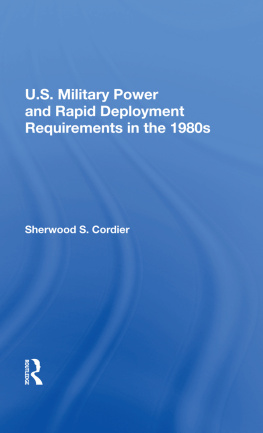Military Power and the Advance of Technology
Also of Interest
Thinking About National Security: Defense and Foreign Policy in a Dangerous World, Harold Brown
Laser Weapons in Space: Policy and Doctrine, edited by Keith B. Payne
U.S.Defense Planning: A Critique, John Collins
Changing U.S. Military Manpower Realities, edited by Franklin D. Margiotta, James Brown, and Michael Collins
Nuclear Deterrence in U.S.-Soviet Relations, Keith B. Payne
Arms Control and Defense Postures in the 1980s, edited by Richard Burt
The Future of European Alliance Systems: NATO and the Warsaw Pact, edited by Arlene Idol Broadhurst
Arms Control in Transition: Proceedings of the Livermore Arms Control Conference, edited by Warren Heckrotte and George C. Smith
Strategy, Doctrine, and the Politics of Alliance: Theatre Nuclear Force Modernisation in NATO, Paul Buteux
The Evolution of U.S. Army Nuclear Doctrine, 1945-1980, John P. Rose
U.S. Military Power and Rapid Deployment Requirements in the 1980s, Sherwood S. Cordier
The Defense of the West: Strategic and European Security Issues Reappraised, edited by Robert Kennedy and John M. Weinstein
Arms Control and International Security, edited by Roman Kolkowicz and Neil Joeck
Toward Nuclear Disarmament and Global Security: A Search for Alternatives, edited by Burns H. Weston
The Nuclear Freeze Debate: Arms Control Issues for the 1980s, edited by Paul M. Cole and William J. Taylor, Jr.
Available in hardcover and paperback.
Westview Special Studies in Military Affairs
Military Power and the Advance of Technology: General Purpose Military Forces for the 1980s and Beyond
Seymour J. Deitchman
This new, fully revised edition of Dr. Deitchman's New Technology and Military Power (Westview, 1979) reflects the changes of the past five years, some of them major, in the world situation, in U.S. perceptions of national security needs, in U.S. assessments of the balance between strategic and general purpose weapons systems, and in the evolution of high technology weapons. Addressing our urgent need for multipurpose rapid deployment forces that can be sustained for fairly long periods, the book answers many important questions that have been discussed in Congress, at the Pentagon, in the White House, and, of course, in public debate: How has modern technology influenced the basic components of national security? Why must we now spend so much of our national budget to build credible general purpose forces? Is high technology running away with our military establishments and is it compatible with a large carrier force and a fleet of nuclear submarines? Why must we create an enormous arsenal of sophisticated nonnuclear weapons designed to assure victory in a battle where nuclear weapons will not be used by any of the combatants? Why do we need the potential of a preemptive presence in faraway theaters?
Dr. Deitchman also deals with the basic facts of the military-industrial complex, examining its institutional dynamics and constitutional barriers to change, its technological drive, and its societal inertia. He shows how simplistic journalistic prescriptions and trivial observations fail to do justice to the enormous complexity of an industrial economy with strong survival instincts and scientific energies.
Seymour J. Deitchman is vice-president, planning and evaluation, of the Institute for Defense Analyses, Arlington, Virginia. He spent five years with the Defense Department in various executive positions and was formerly the chairman of a NATO panel that studied some of the problems discussed in this book.
Preparation of this book was supported by a grant from the Central Research Program of the Institute for Defense Analyses
First published 1983 by Westview Press
Published 2018 by Routledge
52 Vanderbilt Avenue, New York, NY 10017
2 Park Square, Milton Park, Abingdon, Oxon OX14 4RN
Routledge is an imprint of the Taylor & Francis Group, an informa business
Copyright 1983 by Taylor & Francis
All rights reserved. No part of this book may be reprinted or reproduced or utilised in any form or by any electronic, mechanical, or other means, now known or hereafter invented, including photocopying and recording, or in any information storage or retrieval system, without permission in writing from the publishers.
Notice:
Product or corporate names may be trademarks or registered trademarks, and are used only for identification and explanation without intent to infringe.
Library of Congress Catalog Card Number 83-50434
ISBN 13: 978-0-367-01980-8 (hbk)
Before I built a wall I'd ask to know
What I was walling in or walling out...
Robert Frost
The general purpose military forces include the tanks of the Army, the airplanes of the Air Force, the ships and airplanes of the Navy, the Marines, and all that go with them. They comprise, essentially, all of our military forces other than the intercontinental nuclear forces. Under the umbrella of the balance of strategic deterrence, the general purpose forces are the ones that do the difficult work of projecting the image and the reality of American military power overseas.
These forces, together with a pro rata share of their essential support and the airlift and sealift needed to help them deploy overseas, absorb between 80 and 85 percent of the defense budget. They contain or occupy about 90 percent of the Defense Department's manpower. The problems they engender and the issues they raise for defense policy are legion. They can be treated in all their glory and at great length, and their various aspects have been the subject of many recent works. A comprehensive treatment of the general purpose forces was my original purpose in this book, but it did not work out that way.
As I attempted to come to grips with the problems involved in creating, sustaining, and using the general purpose forces, one underlying circumstance gradually became apparent: The advance of technology since World War II has transformed these forces, as it has transformed our society. It has changed their structure, their operations, their budgets. It has created the most serious problems they face, no matter how those problems are expressedin terms of cost, operational capability, force size, or the value of specific systems. Yet these latter manifestations are the matters about which most of the explicit arguments on defense policy, outside the strategic force areas, revolve. Even a cursory survey of how the news media report on military matters shows that as a nation we still tend to visualize our armed forces as being similar to those that fought and won World War II. It may be that this view persists because, for most Americans, movies based on World War II are the main illustration of how the armed forces operate. Whatever the reason, it is from the clash between these outdated perceptions of our armed forces and what they have actually become that most of the cost, capability, and size arguments arise. We must exert a conscious effort to resolve these dissonances, or we will never see rational planning of the parts of our military forces that most visibly contribute to and influence our foreign policy.













